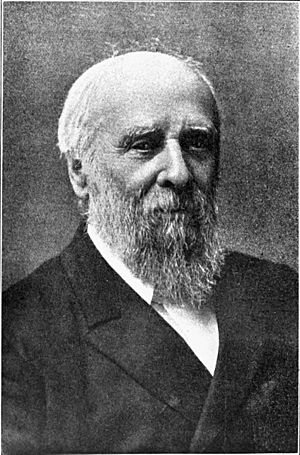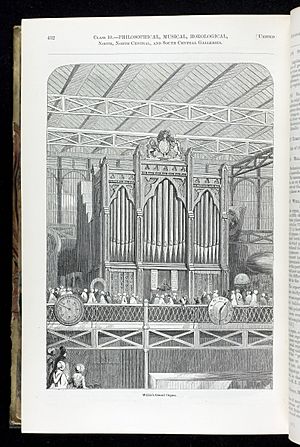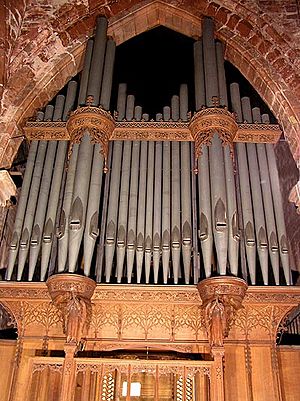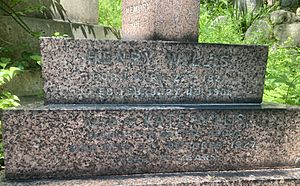Henry Willis facts for kids
Henry Willis (born April 27, 1821 – died February 11, 1901) was a very famous English organ builder and player. People often called him "Father" Willis because he was considered the best organ builder during the Victorian era. His company, Henry Willis & Sons, is still building organs today!
Contents
Early Life and How He Started
Henry Willis was born in London. His father was a builder. Henry learned to play the organ with help from George Cooper and Thomas Attwood. Attwood was the organist at St Paul's Cathedral.
In 1835, when Henry was 14, he started training with an organ builder named John Gray. He trained for seven years. During this time, he invented special parts for organs called manual and pedal couplers. He used these inventions in all his organs later on.
After his training, Henry worked for three years in Cheltenham. He helped a person named Wardle Evans who made musical instruments with "free reeds." This experience taught Henry a lot about how to make organ reeds sound amazing.
Henry met a musician named Samuel Sebastian Wesley in Cheltenham. This meeting led to Henry rebuilding the organ at Gloucester Cathedral in 1847. This was a huge step for him! He said it was his "stepping stone to fame."
Becoming Famous
In 1851, there was a very big event called the Great Exhibition. Henry Willis built the largest organ there. It had 70 "speaking stops," which was a lot for that time! He also added new features to his organs. He put in "piston buttons" that let players change sounds quickly. He also used a special system called "Barker lever servo action." This made it easier to play such a big and complex instrument.
After the exhibition, parts of this huge organ were moved to Winchester Cathedral. In 1854, it had 49 stops and a new type of pedalboard. This special pedalboard was a joint idea between Willis and Samuel Sebastian Wesley. They worked together again on another massive organ with 100 stops for St George's Hall, Liverpool in 1855.
The Best Organ Builder of His Time
Building the organ for the Great Exhibition helped Henry get the job for St George's Hall in Liverpool. A talented organist named W.T. Best played this organ. Many people came to listen, and this made Henry Willis even more famous.
Throughout his long career, Henry built or rebuilt about 1,000 organs! Some of his most famous organs are in places like the Royal Albert Hall and St Paul's Cathedral in London. He also built organs for many cathedrals across England, such as Canterbury, Durham, Exeter, and Salisbury.
One of the last big organs he personally worked on was at St Bees Priory in 1899. He was almost 80 years old but still helped make sure the organ sounded perfect.
Henry Willis as an Organist
Besides building organs, Henry Willis was also an organ player himself! He held several organist jobs. He played at Christ Church in Hoxton in 1835. Later, he was the organist at St John-at-Hampstead and then Christ Church, Hampstead. He even built the organ at Christ Church, Hampstead. For almost 30 years, he played at the Chapel-of-Ease, Islington (now St Mary Magdalene Church).
His Family
Henry Willis married Esther Maria Chatterton in 1847. They had five children:
- Vincent Willis (1848–1928)
- Edith Willis (1850–1947)
- Henry Willis II (1852–1927)
- Kate Willis (1853–1927)
- Mary Willis (1859–1952)
After Esther died in 1893, Henry married her younger sister, Rosetta Chatterton, in 1894.
His Lasting Impact
Henry Willis passed away in London on February 11, 1901. He is buried in Highgate Cemetery.
You can still find his amazing organs all over the world, especially in places that were once part of the British Empire. His organs are known for their beautiful sounds and excellent craftsmanship. The very last organ he built was at St Nicholas' Chapel in King's Lynn.
The Willis family continued the tradition of building organs for four generations. In 1997, Henry Willis IV retired. Today, the company, Henry Willis & Sons, still makes organs in Liverpool.






